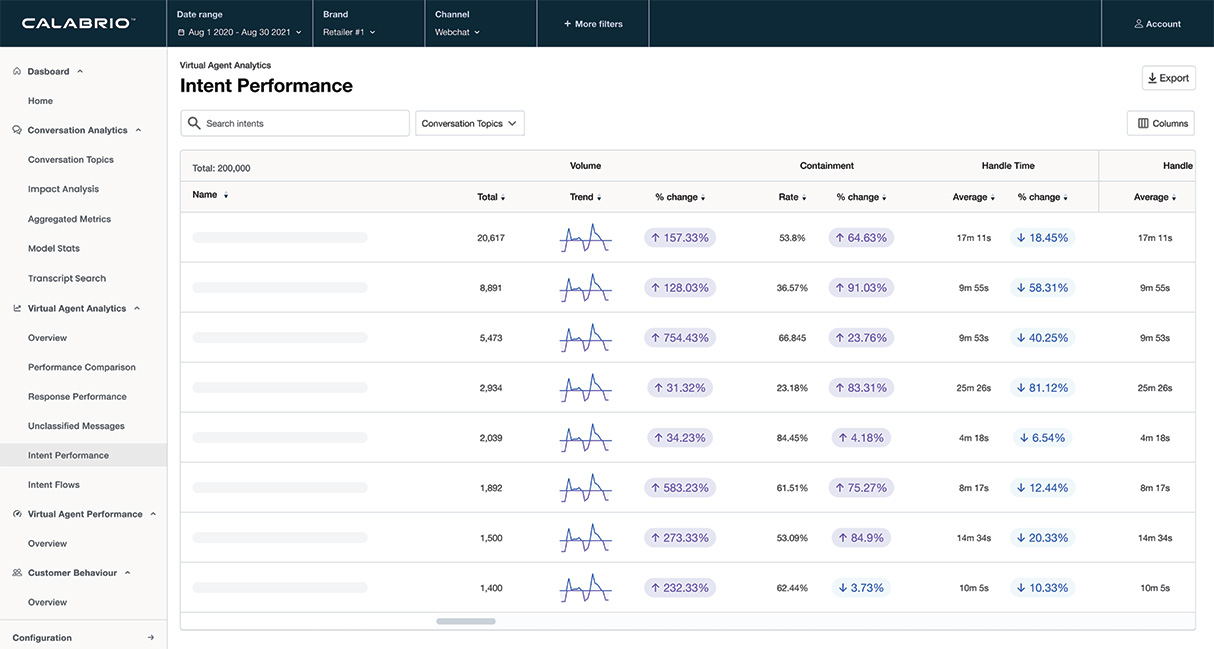Managing Mental Health in the Contact Center
Managing Mental Health in the Contact Center

With a growing number of people struggling with mental health conditions, contact center workers are no exception. The demands of a contact center can wear down agents over time if they aren’t supported. Since one in three agents are considering leaving the field, finding ways to beat agent burnout is vital for contact centers.
Since contact center leaders aren’t mental health professionals, they don’t have the first-hand experience and knowledge to navigate people dealing with difficult conditions. This is why there needs to be training so that managers can confidently respond to struggling staff members while sparing them embarrassment or scrutiny.
This article examines ways that leaders can better understand how high-intensity customer interactions impact agents, identify additional workplace stressors and learn tactics to reduce them for greater workplace wellness.

Taking Calls Can Take a Toll
Call center agents help customers all day, and often, one right after the other. Leaders use this information to measure the occupancy, or time spent occupied with customers, to schedule the correct number of agents to take phone calls at any given time. When there is a high volume of calls without enough agents to respond, this can lead to stressful situations, call fatigue and eventually burnout.
High-intensity or negative customer inquiries can cause service agents added stress, making their nervous system react in an instinctual way. This is called the body’s natural stress response, more commonly known as flight, fight or freeze. When humans sense danger, an alarm is triggered in their mind to start releasing adrenaline and cortisol. These hormones prepare the body to face the perceived threat. It’s important to note that this process occurs instantly and on a cellular level.
When we’re in highly stressful situations, blood starts pumping to the heart, digestion slows and breath gets shallow in preparation for action. All of this happens to help prepare us to deal with the perceived (or very real) threat. After this initial rush, our bodies need time to return to normal.
Dealing with Stress in Contact Centers
In the modern world, there are many things that trigger these responses. Instead of dealing with rare high-stress situations or attacks, we are getting more of it throughout the day. Questions like “Did I forget to send that email?” or “Did I turn the stove off?” can send adrenaline and cortisol rushing into our system.
Since contact centers can be high-stress environments, employees need to return to their normal baseline after intense customer inquiries. When there is a high occupancy rate, agents have less to no time to decompress after stressful interactions, which increases stress over time. This can lead to greater mental fatigue or even developing other mental health conditions.
How Stress Impacts Contact Center Performance
Organizations need to help their customer service agents manage the stress of busy contact centers. This is even more important with the digital transformation of the contact center. Managing remote agents brings its own unique challenges.
By monitoring KPIs, leaders can try to preempt situations before problems escalate. Common indicators include lateness, absences and other KPI drops. In the most effective contact centers, mental health issues are a part of the discussion at all levels, especially HR, management and recruitment.

Steps to Help Improve Mental Health in the Workplace
Promoting workforce wellbeing is the first step in creating a healthier contact center. Issues that linger can lead to bigger problems, burnout and agent attrition over time. Employees at every level should be encouraged to discuss concerns. Contact center managers should also be able to help assist and make positive improvements to help.
In the Working Smarter Podcast Episode, Mental Health in the Contact Center, the host Dave Hoekstra sits down with Michelle Bunch, a licensed clinical social worker, to discuss how to improve mental health in the contact center. Since handling difficult customer interactions can heavily weigh on one’s emotional, mental and physical health, it’s essential to create steps to improve agent wellbeing in call centers. Read on to discover some ways to do so below.
Tackle Work-Related Stressors
After promoting healthy living in the workplace, the next step is to address work-related stressors. Most agents take 30 to 80 calls a day, 5 days a week, 7 and a half hours a day with limited breaks. Some advisors solely deal with complaints and have to deal with them back-to-back. If managers don’t allow for breaks in between these high-intensity conversations, employees’ stress baseline increases, and they could eventually get stuck in a freeze response. This can look like someone who is always sleepy, exhausted, overwhelmed about calls, etc.
Recalibrate After High-Stress Situations
More empathetic agents can deliver better customer experiences, so it’s essential to find ways for agents to calm down and recenter themselves after triggering calls. Look at some examples below:
Self-Scheduling
This empowers contact center agents to take control of their schedules throughout the day. It can help them build in necessary breaks when they are feeling overwhelmed.
Stretching and Moving
Sometimes the best way to relieve tension after a stressful call is to physically get up, stretch and move one’s body around. This can help make agents feel more grounded and centered by physically “shaking off” the built-up tension.
Meditating
Taking a few deep breaths or using a meditation app for a quick break can help to calm nerves and refocus energy.
Removing the Stigma of Mental Illnesses
While everyone has hard days or time periods, some individuals’ ‘bad days’ are due to their symptoms of mental illness, like anxiety, depression, bipolar disorder, etc. Since these mental health conditions vary in severity, some employees may need different requirements than others.
According to the Equal Employment and Opportunity Commission (EEOC), employers generally cannot ask individuals about their mental health status, unless a modification or reasonable request is needed, everyone is asked after hiring, or they are trying to track those with disabilities for hiring purposes.
Since contact center leaders cannot outright ask employees if they are struggling with a mental illness, there are other ways to help spot warning signs and initiate a safe space for their team. Encourage discussions and agent feedback about these experiences. With an increase in disgruntled customers and larger call volumes, it’s a good idea to get agent feedback about ways to help alleviate these stressful situations. It’s also essential to notice what triggers these bodily responses so that employees can get back to normal faster.

Actively Encourage a Healthy Work-Life Balance
Having easy access to helpful resources is vital for those struggling. Agents and operation staff need to know where they can turn to for support without having to confide directly in a superior.
Include user-friendly resources, such as:
• Videos
• Personal stories
• Tips
• Helpful articles
• Easy-to-read mental health policies
Organize monthly mindfulness sessions to engage the team with different health and wellness topics. These could be de-stress techniques, yoga classes, complimentary massage sessions or seminars about how to improve sleep. These programs help advisors feel respected and assisted to better achieve a work-life balance.
Remember to keep in mind ways to include advisors working in virtual contact centers through mindful meditation classes or incentives to work from the office once or twice a week.
Train Leaders for Effective Mental Health Conversations
A great leader should be able to spot agent problems as they arise and find helpful solutions. Learning how to discuss difficult topics will help leaders mitigate problems and get ahead of issues. Leaders need to learn how to identify warning signs of stress while also knowing how to pinpoint problems with an individual like:
• Are they arriving late to work?
• Do they look tired often?
• Are they losing focus?
• Are an employee’s work habits changing?
• Are they struggling to meet the demands of the job?
• Do they form good relationships with their colleagues?
Well-trained leaders should hold conversations with agents to discreetly discuss their concerns without judgment. Reaffirm them of the organization’s support, offer resources and acknowledge that if one person is feeling this way, most likely there are others who have not yet come forward.
Improve the Physical Environment
The physical environment of your contact center can impact your agent’s wellbeing. Small, dark cubicles can leave advisors feeling disconnected from the team and can lead to a lack of motivation. Making small changes by introducing open floor plans, adding more natural and artificial lights, encouraging movement and adding greenery can give a boost of energy to your team. These small changes can help stave off fatigue, agitation and depression.
Added background noise can also lead to irritation, so consider adding noise canceling and white noise machines to the space. Consult with your agents to see what they need within their space to better support their frontline services.

Support Employees Struggling with Mental Health Issues
Create an environment where agents feel accepted and can talk to people who care about them. There are several ways to help build this culture through intervening early, providing a confidential email address and offering support to those coping with bereavement. Don’t shy away from bringing in qualified help from outside of the organization.
Addressing mental health in the contact center can be a rather delicate issue. As leaders, it’s important to learn ways to reach out to struggling employees with compassion. If you’re looking for great ways to help promote agent wellbeing in the workplace, download Calabrio’s Workforce Wellbeing Recovery Toolkit. It’s an in-depth resource that includes helpful advice on how to aid stressed agents.









